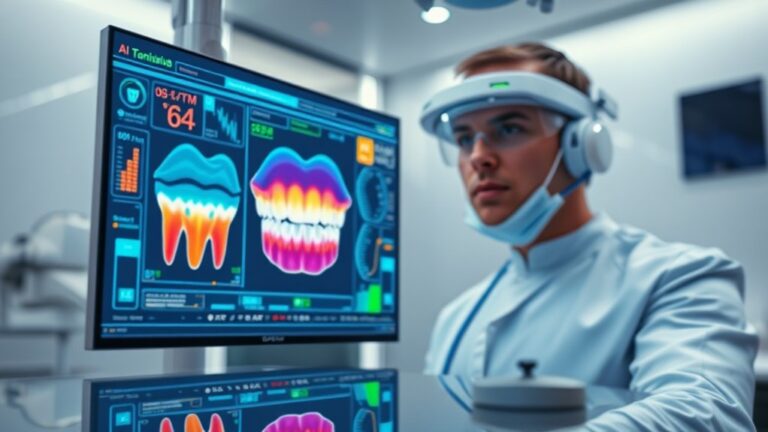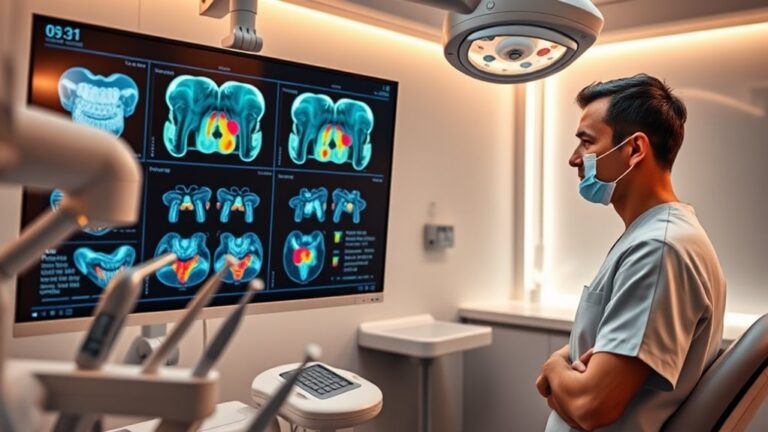Revolutionize Dental Care: 3 Predictive Analytics Insights
You might not realize how predictive analytics is reshaping dental care, but its impact on patient outcomes is significant. By analyzing extensive data, you can now anticipate oral health issues before they escalate. Imagine having a personalized treatment plan tailored just for you, based on your unique risk factors. As you consider the implications of these insights, it becomes clear that the potential for early detection and operational efficiency is just the beginning. If you're interested in exploring how predictive analytics can enhance your dental health, feel free to contact us. We can connect you with experts who can provide tailored solutions and insights. So, what are the three key insights that could change your perspective on dental health forever?
Early Detection and Prevention
Early detection and prevention in dental care are revolutionized by predictive analytics, which leverages extensive datasets to forecast oral health outcomes. By employing advanced algorithms, you can identify risk factors associated with conditions like tooth decay, gum disease, and oral cancer.
Through thorough oral screenings, AI analyzes your unique data—diet, hygiene habits, and medical history—to predict potential health issues before they escalate. The integration of predictive analytics enhances the accuracy of dental imaging, allowing for the detection of even the slightest signs of decay that might otherwise go unnoticed. This early intervention not only preserves more of your natural tooth structure but also reduces the need for invasive procedures, ultimately improving patient outcomes.
Furthermore, by predicting risks associated with oral cancer based on demographic and lifestyle factors, predictive analytics plays a vital role in cancer prevention. The insights derived from this data-driven approach empower both you and your dental professionals to implement targeted preventive measures, leading to better overall oral health and substantially lowering healthcare costs. Additionally, the ability to forecast oral health outcomes helps in tailoring personalized interventions based on your medical history and lifestyle choices.
Embracing these innovations guarantees you contribute to a proactive dental care environment focused on early detection and prevention.
Personalized Treatment Plans
Personalized treatment plans in dental care are transforming the way you receive and engage with your oral health services. By harnessing detailed data collection techniques such as digital radiography and 3D imaging, your dental care team can gather in-depth insights into your unique dental structure and medical history. This information is essential for effective treatment customization, ensuring your specific needs are met.
Machine learning algorithms analyze your data to predict treatment outcomes, identifying potential issues like tooth decay or gum disease before they escalate. This predictive capability allows for tailored treatment plans that align with your preferences and lifestyle, enhancing patient compliance. Additionally, AI engines validate these recommendations, providing a level of precision that traditional methods may lack. AI considers medical conditions like heart disease and diabetes, ensuring that your treatment plan is not only personalized but also aligned with your overall health.
With a focus on high-value strategies and sophisticated workflows, personalized treatment plans lead to improved clinical outcomes and increased treatment acceptance rates. In fact, practices report acceptance levels around 70%, substantially higher than the industry standard.
Operational Efficiency
Operational efficiency in dental care is substantially enhanced through the integration of advanced technologies and data analytics. By automating administrative tasks like appointment scheduling and reminders, you can markedly reduce your team's manual workload.
AI-powered voice assistants can handle common patient inquiries, freeing up staff to focus on critical patient needs—a clear example of automation benefits leading to staff liberation.
Moreover, predictive analytics plays a vital role in inventory management. By analyzing historical data, you can optimize inventory levels, monitor expiration dates, and maintain healthy supplier relationships. This approach not only controls supply costs but also minimizes waste, enhancing overall operational efficiency. In addition, the use of machine learning algorithms helps refine these predictive models for even greater accuracy.
In terms of patient attendance, forecasting attendance patterns allows you to adjust staffing needs proactively. With AI tools, you can minimize scheduling gaps and guarantee an efficient flow of patients, improving their experience.
Streamlining clinical processes, such as AI-assisted periodontal charting and real-time transcription of patient notes, further reduces diagnostic errors and enhances the quality of care.
Frequently Asked Questions
How Does Predictive Analytics Impact Dental Insurance Claims Processing?
Predictive analytics substantially enhances dental insurance claims processing by enabling claims optimization and reimbursement forecasting. You'll identify errors early, predict approval outcomes, and streamline workflows, ultimately improving efficiency and patient satisfaction through informed decision-making.
Can Predictive Analytics Reduce the Need for Emergency Dental Visits?
Predictive analytics can substantially streamline services, supporting early intervention and preventive measures. By identifying high-risk patients, you can proactively reduce emergency dental visits, ensuring better outcomes and enhanced patient satisfaction within your practice.
What Role Does Patient Data Privacy Play in Predictive Analytics?
Patient data privacy plays a critical role in predictive analytics. You must implement strong data security measures and compliance protocols to protect sensitive information, ensuring ethical use while maintaining trust and enhancing patient care outcomes.
How Can Predictive Analytics Improve Dental Staff Training Programs?
Predictive analytics substantially enhances staff optimization by identifying key behavior training needs. By analyzing performance data, you can tailor training programs to improve staff efficiency, ultimately leading to better patient care and satisfaction.
Are There Specific Software Tools for Implementing Predictive Analytics in Dental Practices?
To implement predictive analytics in your dental practice, consider software tools that guarantee data integration and workflow optimization. These tools enhance efficiency and decision-making, ultimately improving patient care and practice performance through actionable insights.
Conclusion
Incorporating predictive analytics into dental care isn't just innovative; it's transformative. For instance, studies show that practices using predictive tools can increase early detection rates of cavities by up to 30%. By identifying risks before they escalate, you can take proactive steps that not only improve patient outcomes but also enhance overall operational efficiency.
If you're looking to implement these insights effectively, don't hesitate to reach out to us for expert assistance. Our team can help you navigate the complexities of predictive analytics, saving you time and reducing stress while improving the overall performance of your dental practice. Embracing these insights with our guidance can lead to healthier smiles and a more effective practice, ensuring you stay ahead in the evolving landscape of dental care.





